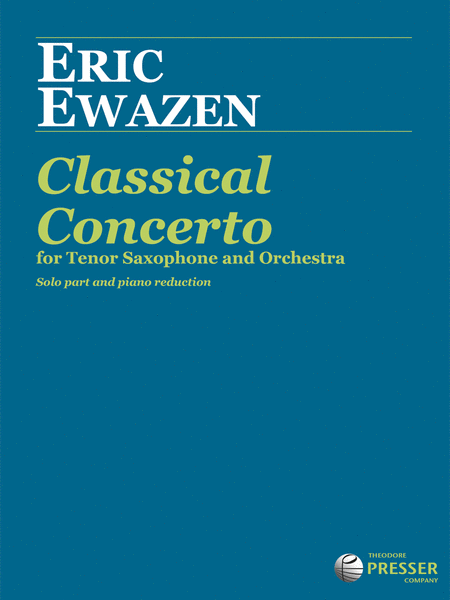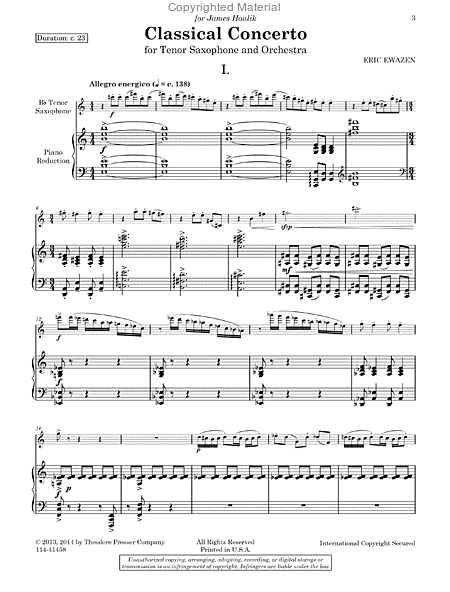Classical Concerto
for Tenor Saxophone and Orchestra
-
Ships in 1 to 2 weeks
Details
Description
SKU: PR.114414580
For Tenor Saxophone and Orchestra. Composed by Eric Ewazen. Sws each. Set of Score and Parts. With Standard notation. 36+12 pages. Duration 23 minutes. Theodore Presser Company #114-41458. Published by Theodore Presser Company (PR.114414580).ISBN 9781598066210. UPC: 680160598052. 9x12 inches.
The concerto and recital repertoire for saxophone is centered around alto sax literature, making this 23-minute tenor concerto by Eric Ewazen a striking landmark. Commissioned by celebrated tenor saxophonist James Houlik, Ewazen’s Classical Concerto earns its title through the use of traditional musical forms, and neoclassical approaches to lyricism. The concerto is recorded by Houlik on the Albany label. Orchestral materials are available on rental.
CLASSICAL CONCERTO is gratefully dedicated to James Houlik, who was responsible for its creation. Jim heard my music for brass and immediately took to my style, harmonic language, and approach to lyricism and structure, which was very much influenced by composers of the 19th century, hence the title CLASSICAL CONCERTO. The title is also an homage to Prokofiev’s “Classical” Symphony and other neo-classical works that combine 20th-century harmonic language with the classical aesthetics of form and structure.This piece has been important to me for many reasons. Composed in 1991-92, it was my first work for full orchestra following my graduation from Juilliard in 1980. I had written my Chamber Symphony in 1986, but all the other pieces from the decade after graduating were for chamber ensembles, soloists, and vocal and choral music. This concerto was also my first large work featuring saxophone. I vividly remember when Jim Houlik came to my apartment to play tenor sax for me to show all it could do. Wow! Was I knocked out by the beauty of his tone, his spectacular virtuosity, the extraordinary range of the instrument, and the excitement of the sound! I was hooked! Jim has made it his mission to expand the repertoire of his beloved tenor sax, and to date has commissioned well over 100 major works for the instrument by some of the most distinguished composers of our time. I was determined to write a showpiece that captured his amazing playing with a concerto that also allowed the orchestra to supply resonant, buoyant support.The first movement starts with a bang: full, rich, resonant chords, a brightly dramatic saxophone line, and gestures that continually cascade, displaying the awesome range of the instrument. But in true neoclassical style, the movement is in strict sonata-allegro form, with an episodic transition leading to an appassionato and lyric 2nd theme, and a heroic closing theme. A subsequent modulating development culminates in a dramatic return to the opening melodies in the recapitulation, an extremely virtuosic cadenza, and a final culminating coda.The second movement shows off the truly soulful sound of the saxophone as it sings a heartfelt ballade. I remember playing a recording of this piece for Ned Rorem, and he commented how close to the human voice the saxophone is – and how American jazz-influenced composers have embraced the sound of the instrument – and that is just was I was trying to do with this movement: let the saxophone sing either as a soloist, or as a soloist rising above an orchestral choir with impassioned lines rising to the Heavens.The final movement is an exhilarating rondo with a lively dance in a compound rhythm, and in a minor key that happily moves to major by the conclusion. The dance is interrupted by gestures that are sometimes contrapuntal, sometimes fanfarish, but always lively and joyful. As if the saxophone player has not played enough (!), I’ve added one more cadenza to the end of the 3rd movement, turning the concerto into a virtuosic showpiece for the tenor saxophone, and the piece ends grandly with a celebratory finale.My sincerest thanks to my dear friend James Houlik for inspiring this work. Thanks also to Todd Stanton for coordinating a joint commission from the Western Piedmont Symphony of North Carolina conducted by John Gordon Ross, and the Bellevue (WA) Philharmonic, where the initial premiere performances took place. The work was subsequently recorded with Jim Houlik and the Prague Chamber Orchestra for Albany Records (TROY477).


 Share
Share